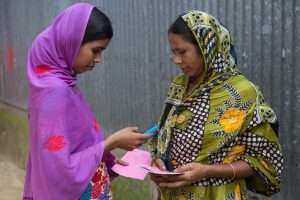 |
| Image Courtesy: BRAC |
Mobile-based financial services are a fairly recent entrant into Bangladesh’s financial ecosystem (2011).With entrenched systemic barriers that influence women’s access to mobile phones, the low uptake and usage of MFS among women does not come as a surprise. Moreover, low financial literacy, particularly among women in the bottom-of-the-pyramid segment, poses a challenge for them in transitioning from traditional models to mobile-based platforms. In such a scenario, handholding and guiding women towards the assisted use of mobile platforms can promote their uptake and usage. For instance, a training program initiated by BRAC on numeracy and mobile money for women in remote areas has had a positive impact on the usage of these services by them. Going forward, it is important for policymakers and practitioners to acknowledge the power of self-learning and peer learning as channels that can bring more women into the ambit of mobile financial services – even though this process may take time to demonstrate results.
Applying principles of Human Centered Design
In addition to addressing the systemic barriers to access and usage, a lot can be done by financial service providers (FSP) in innovating product design and delivery. There is significant scope for current mobile-based offerings to be tailored towards the needs of specific target audiences such as women. FSPs must recognize the need to create intuitive and easy to use platforms that can operate on the simplest of phones- users must be able to “mentally map” out the keys and shortcuts that can enable these transactions. At the same time, improving the value propositions of these products and services is equally important. All this can be made possible by applying the principles of human centered design to digital finance. As smartphone penetration increases in rural Bangladesh, focusing on product feasibility, viability and usability can open an exciting range of possibilities for both FSPs and women in remote areas.
MFS: Not a silver bullet?
In spite of the initial excitement surrounding MFS, there is a need to temper expectations from these services, as they are not a silver bullet to address all existing issues of financial exclusion.
More research required
Having a registered mobile money account in her name does not necessarily imply that a woman is “financially included”. Conversely, not having a mobile money account need not mean that a particular woman is financially excluded; she may have access to financial services through SHGs or other delivery channels. Moreover, in low-income countries, it is often observed that members of a household share the usage of a mobile phone. Thus, using individual access as a metric to measure financial inclusion may not adequately capture the household dynamics and complexities in access to these services. Even if we focus on individual access, financial services for the poor are ultimately consumed by the household – this has to be factored in as we move forward. While MFS providers strengthen their presence across select demographics and areas of Bangladesh, further research is required to understand the barriers that are preventing women from availing the benefits of these services, in larger numbers.
Conversing with Stakeholders
At a seminar on ‘Digital financial inclusion: Innovations from Bangladesh’ organized by BRAC Social Innovation Lab, Access to Information (a2i) and USAID’s mSTAR project implemented by FHI 360, leading practitioners, policymakers, researchers, MFS Providers and sector experts came together to deliberate on the progress of digital finance in Bangladesh. The consensus among the experts was that while the sector has made tremendous progress in promoting financial inclusion in the country, much remains to be achieved in order to tap the full potential of digital finance in reaching excluded sections, especially women. In addition to developing innovative and well-designed products and platforms that are in tune with needs and capabilities of women, the need of the hour is to ensure that the systemic barriers that prevent women in Bangladesh from accessing these services are alleviated. This will allow ease of access and enable women to receive all the benefits of mobile financial services. The results will be evident – slowly, but surely.
The authors would like to thank Tanjilut Tasnuba, Maria May, and Masrura Oishi from the BRAC Social Innovation Lab for their valuable inputs on this article.


